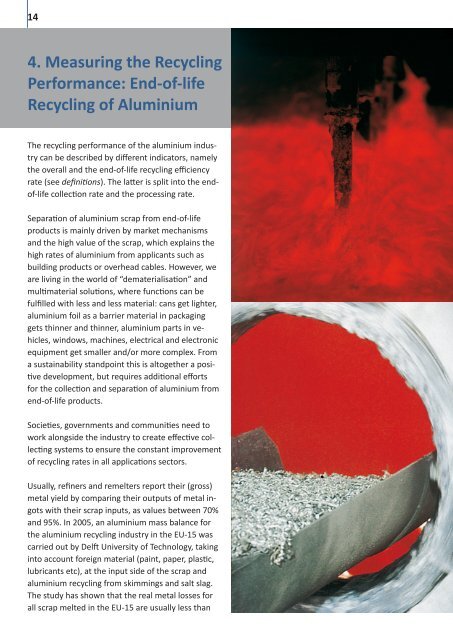Global Aluminium Recycling Brochure - Transport
Global Aluminium Recycling Brochure - Transport
Global Aluminium Recycling Brochure - Transport
Create successful ePaper yourself
Turn your PDF publications into a flip-book with our unique Google optimized e-Paper software.
14<br />
4. Measuring the <strong>Recycling</strong><br />
Performance: End-of-life<br />
<strong>Recycling</strong> of <strong>Aluminium</strong><br />
The recycling performance of the aluminium industry<br />
can be described by different indicators, namely<br />
the overall and the end-of-life recycling efficiency<br />
rate (see definitions). The latter is split into the endof-life<br />
collection rate and the processing rate.<br />
Separation of aluminium scrap from end-of-life<br />
products is mainly driven by market mechanisms<br />
and the high value of the scrap, which explains the<br />
high rates of aluminium from applicants such as<br />
building products or overhead cables. However, we<br />
are living in the world of “dematerialisation” and<br />
multimaterial solutions, where functions can be<br />
fulfilled with less and less material: cans get lighter,<br />
aluminium foil as a barrier material in packaging<br />
gets thinner and thinner, aluminium parts in vehicles,<br />
windows, machines, electrical and electronic<br />
equipment get smaller and/or more complex. From<br />
a sustainability standpoint this is altogether a positive<br />
development, but requires additional efforts<br />
for the collection and separation of aluminium from<br />
end-of-life products.<br />
Societies, governments and communities need to<br />
work alongside the industry to create effective collecting<br />
systems to ensure the constant improvement<br />
of recycling rates in all applications sectors.<br />
Usually, refiners and remelters report their (gross)<br />
metal yield by comparing their outputs of metal ingots<br />
with their scrap inputs, as values between 70%<br />
and 95%. In 2005, an aluminium mass balance for<br />
the aluminium recycling industry in the EU-15 was<br />
carried out by Delft University of Technology, taking<br />
into account foreign material (paint, paper, plastic,<br />
lubricants etc), at the input side of the scrap and<br />
aluminium recycling from skimmings and salt slag.<br />
The study has shown that the real metal losses for<br />
all scrap melted in the EU-15 are usually less than


